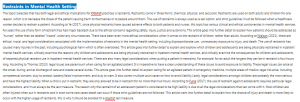Initial Discussion Post

Top of Form
Restraints in Mental Health Setting
The topic I selected that has both legal and ethical implications for PMHNP practices is restraints. Restraints come in three forms: chemical, physical, and seclusion. Restraints are used on both adults and children for one reason, which is to decrease the chase of the patient causing harm to themselves or to people around them. The use of restraints is always used as a last option, and strict guidelines must be followed when a healthcare worker decides to restrain a patient. According to Ye (2017), since physical restraints have caused adverse effects to both patients and nurses, this topic has various clinical and ethical controversies in mental health services. For years the use of any form of restraint has had major backlash due to the ethical concerns regarding safety, injury, justice and autonomy. This article goes into further detail to explain how patients should be addressed as “human” rather than be labeled “insane” under any circumstances. There have been even more ethical considerations when it comes to the restraint of children, rather than adults. According to Nielson (2021), there are ethical, moral, and legal considerations associated with the implementation of restraints in the mental health setting, including disproportionate use, unnecessary exposure to injury, and death. The use of restraints has caused many injuries in the past, including psychological harm which is often overlooked. This article goes into further detail to explain and explore which children and adolescents are being physically restrained in inpatient mental health services, critically examine the reasons why children and adolescents are being physically restrained in inpatient mental health services, and critically examine the consequences for children and adolescents of reported physical restraint use in inpatient mental health services. There are also many legal considerations when putting a patient in restraints. For example, for an adult the longest they can be in restraint is four hours long. According to Thomas (2013), legal issues are paramount when caring for an agitated patient. It is imperative to have a clear understanding of these issues to avoid exposure to liability. These legal issues can arise at the onset, during, and at discharge of care and create several duties. This article goes into further detail to explain caring for an agitated patient in emergency medicine, multiple areas of medico-legal risk arise, including competence/consent, duty to protect, battery/false imprisonment, and duty to warn. It also covers multiple court cases on how to avoid liability. Lastly, legal considerations amongst children are probably the most serious, and have the highest liability. When a child is put in restraint, they are only allowed to be in restraint for no more than two hours. According to Furre (2017), the use of restraint against adolescents requires particular legal considerations, and must always be the last measure. The reason why the restraint of an adolescent patient is considered to be high liability is due to all the legal considerations that can come with it. Most children are often injured when put in restraints and in even some rare cases death can occur if those strict guidelines are not followed. This article went into further detail to explain how the chance of injury and death is more likely to occur with the higher usage of restraints, this is why it should be avoided till a dractist last measure.
References
Furre, A., Falk, R. S., Sandvik, L., Friis, S., Knutzen, M., & Hanssen-Bauer, K. (2017). Characteristics of adolescents frequently restrained in acute psychiatric units in Norway: a nationwide study. Child and adolescent psychiatry and mental health, 11, 3. https://doi.org/10.1186/s13034-016-0136-1
Nielson, S., Bray, L., Carter, B., & Kiernan, J. (2021). Physical restraint of children and adolescents in mental health inpatient services: A systematic review and narrative synthesis. Journal of child health care : for professionals working with children in the hospital and community, 25(3), 342–367. https://doi.org/10.1177/1367493520937152
Thomas, J., & Moore, G. (2013). Medical-legal Issues in the Agitated Patient: Cases and Caveats. The western journal of emergency medicine, 14(5), 559–565. https://doi.org/10.5811/westjem.2013.4.16132
Ye, J., Xiao, A., Yu, L., Wei, H., Wang, C., & Luo, T. (2017). Physical restraints: An ethical dilemma in mental health services in China. International journal of nursing sciences, 5(1), 68–71. https://doi.org/10.1016/j.ijnss.2017.12.001
Bottom of Form